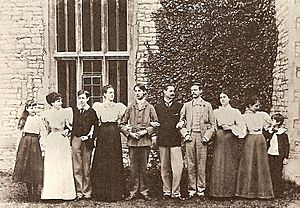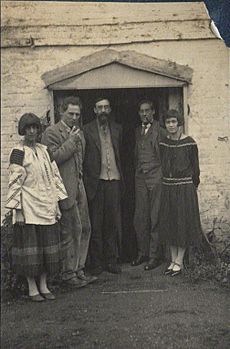Lytton Strachey facts for kids
Quick facts for kids
Lytton Strachey
|
|
|---|---|

A study of Strachey's face and hands by Carrington
|
|
| Born | Giles Lytton Strachey 1 March 1880 London, England |
| Died | 21 January 1932 (aged 51) Ham, Wiltshire, England |
| Occupation | Author, critic |
| Alma mater | |
| Parents | Sir Richard Strachey Jane Grant |
Giles Lytton Strachey (born March 1, 1880 – died January 21, 1932) was an English writer and critic. He was a key member of the Bloomsbury Group, a famous group of writers and artists. Lytton Strachey changed how biographies were written. He made them more interesting by adding humor and looking into the minds of the people he wrote about. His book Queen Victoria (1921) won a special award called the James Tait Black Memorial Prize.
Contents
Early Life and School Days
Growing Up in London
Lytton Strachey was born in London on March 1, 1880. He was the fifth son and eleventh child of Sir Richard Strachey, a British army officer. His mother, Jane Grant, was a strong supporter of the women's right to vote. Lytton was named after his godfather, the first Earl of Lytton, who was a friend of his father. The Strachey family had many children, and ten of them, including Lytton, lived to be adults. His sister Dorothy and youngest brother, James Strachey, were also writers.
When Lytton was four, his family moved to a new home in London. His mother loved languages and books. She encouraged her children to write their own plays and poems from a young age. She believed Lytton could become a great artist. So, she made sure he received the best education. By 1887, he began learning French, a language he admired his whole life.
School Experiences
Strachey went to several schools. His first was a small school in Parkstone, Dorset. He enjoyed acting there and was good at playing female roles. He even told his mother he liked dressing up as a woman to surprise people.
In 1893, his mother sent him to Abbotsholme School in Derbyshire. This school required students to do manual work every day. Lytton was not very strong and did not like this rule. After a few months, he moved to Leamington College. Here, he faced a lot of bullying. His father told him to "grin and bear it." Lytton eventually got used to the school and became one of its best students. His health also got better during his three years there, though he still had some illnesses.

University Life
In 1897, when Lytton was seventeen, his mother thought he was ready for university. She sent him to the University of Liverpool first, as she felt he was too young for Oxford. At Liverpool, he became friends with Walter Raleigh, his favorite teacher. Raleigh greatly influenced Lytton before he went to Cambridge.
In 1899, Strachey tried to get into Balliol College, Oxford. However, the examiners found him shy and nervous. They suggested a different college, which his mother saw as an insult. So, she decided he would go to Trinity College, Cambridge, instead.
Cambridge Years
Lytton Strachey started at Trinity College, Cambridge, in September 1899. He did well in his studies, winning a medal for English Verse in 1902. He earned his degree in History in 1903. He stayed at Trinity until 1905, hoping to earn a special fellowship. He often felt unwell and had to leave Cambridge to recover from heart palpitations.
His time at Cambridge was happy and productive. He made close friends like Clive Bell, Leonard Woolf, and Saxon Sydney-Turner. These friends, along with others, formed a group called the Midnight Society. This group is seen as the beginning of the famous Bloomsbury Group. He also became friends with Thoby Stephen and his sisters, Vanessa and Virginia Stephen.
Strachey also joined the Conversazione Society, known as the Cambridge Apostles. Many famous writers had been members of this group before him. During these years, Strachey wrote a lot of poetry. He also met other important people like John Maynard Keynes and Bertrand Russell. The ideas of philosopher G. E. Moore were especially important to him. Moore believed that true happiness came from having a good quality of life and enjoying great art.
In 1903, Strachey tried to get a job in the Civil Service. Even though his teachers wrote good recommendations for him, he did not get the job. He then focused on getting a fellowship at Trinity College. From 1903 to 1905, he wrote a long paper about Warren Hastings, an important figure in British India. But this work did not get him the fellowship, and he returned to London.
Writing Career
Starting Out as a Writer
After leaving Cambridge in 1905, Strachey lived in a room at his family's home in London. As he got older, living with his family started to bother him. He began traveling more and earned money by writing reviews and articles for magazines like The Spectator. Around 1911–1912, he spent a winter in the countryside and decided to grow a beard, which became his most recognizable feature.

In 1911, a former head of the British Academy, H. A. L. Fisher, asked Strachey to write a short book about French literature. Fisher had read one of Strachey's reviews. Strachey's book, Landmarks in French Literature, was published in 1912. It was dedicated to his mother. The book received good reviews and sold well, but it did not bring Strachey the fame or money he hoped for.
Eminent Victorians and Later Works
After Landmarks was published, Strachey's mother and friends helped him financially. This allowed him to rent a small cottage in the countryside, where he lived until 1916. There, he began writing his famous book, Eminent Victorians.
Strachey's ideas about writing biographies were now fully formed. He was greatly influenced by the novels of Fyodor Dostoyevsky. Later, the ideas of Sigmund Freud also influenced his work, especially his book Elizabeth and Essex.
In 1916, Lytton Strachey moved back to London to live with his mother. In late 1917, his brother and friends helped him rent the Mill House in Tidmarsh, Berkshire.
From 1904 to 1914, Strachey wrote book and theater reviews for The Spectator. He also published drama reviews under the pen name "Ignotus."
During the First World War, Strachey applied to be a conscientious objector, meaning he did not want to serve in the military because of his beliefs. He was eventually excused from military service due to his health. He spent much of the war with friends from the Bloomsbury Group.
His first major success was Eminent Victorians (1918). This book was a collection of four short biographies about important people from the Victorian era. Unlike other biographies of its time, Eminent Victorians explored the lives and minds of historical figures using humor and clever writing. This book made him famous.
He followed this success with Queen Victoria (1921), written in a similar style.
After these successes, Strachey no longer needed financial help. He lived at Tidmarsh until 1924, then moved to Ham Spray House in Wiltshire. This was his home for the rest of his life.
Death
Lytton Strachey died on January 21, 1932, at the age of 51. He passed away from stomach cancer. It is said his last words were: "If this is dying, then I don't think much of it."
Works
Main Books and Biographies
- Landmarks in French Literature (1912)
- Eminent Victorians: Cardinal Manning, Florence Nightingale, Dr Arnold, General Gordon (1918)
- Queen Victoria (1921)
- Books and Characters (1922)
- Elizabeth and Essex: A Tragic History (1928)
- Portraits in Miniature and Other Essays (1931)
Books Published After His Death
- Characters and Commentaries, edited by James Strachey (1933)
- Spectatorial Essays, edited by James Strachey (1964)
- Ermyntrude and Esmeralda. An Entertainment, illustrated by Erté (1969)
- Lytton Strachey by Himself: A Self-Portrait, edited by Michael Holroyd (1971)
- The Really Interesting Question, and Other Papers, edited by Paul Levy (1972)
- The Shorter Strachey, edited by Michael Holroyd and Paul Levy (1980)
- The Letters of Lytton Strachey, edited by Paul Levy (2005)
- Unpublished Works of Lytton Strachey: Early Papers, edited by Todd Avery (2011)
Images for kids
See also
 In Spanish: Lytton Strachey para niños
In Spanish: Lytton Strachey para niños





